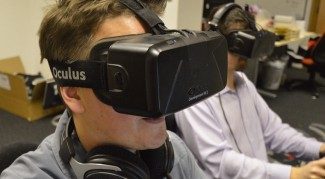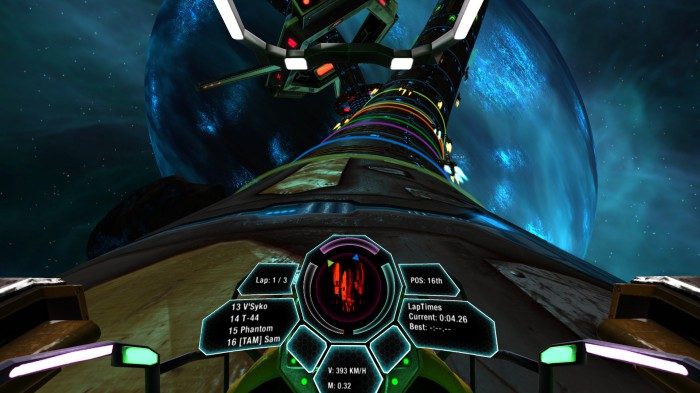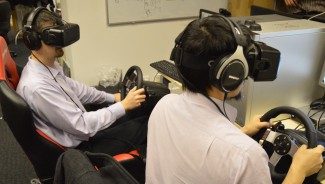 Take a room full of geeks, a collection of networked gaming PCs, a trio of Oculus Rift DK2s and the latest virtual reality racers and what do you have? A somewhat unconventional christmas party.
Take a room full of geeks, a collection of networked gaming PCs, a trio of Oculus Rift DK2s and the latest virtual reality racers and what do you have? A somewhat unconventional christmas party.
The place, an office building somewhere in the North of England. The time, just before Christmas 2014. A band of engineers decide to actively spurn the well worn UK Xmas tradition of heading out into the cold, dining on inedible turkey before getting slowly (or rapidly, depending how little inedible turkey was consumed) smashed on cheap booze. Instead, this year there would be drinks, curry and a VR-infused LAN party!
The event was christened ‘Chunderfest’ on account of the ambitious mix of spicy food and the unsettling effect of virtual reality on those without ‘VR Legs’. The event was also a handy opportunity to dispel the myth that VR was inherently unsociable and solitary, by playing some top notch multi-player games wearing the Oculus Rift.
The setup was modest, 4 gaming PCs, 3 Logitech G27 wheels with pedals and 3 Oculus Rift DK2’s. The original plan was to concentrate purely on multi-player iRacing — one of the finest sim-racers out there with excellent Rift support — but we really needed some arcade racing action to lighten up the mood as well. Radial-G, Tammeka‘s excellent futuristic racer, recently released in early access form via Steam, was the obvious choice – but it lacked local multi-player.
See Also: Hands On with ‘Radial G’ Steam Early Access Demo (60 FPS Gameplay Video)
 As a shot in the dark, I fired a message off to Tammeka’s Producer and Community Manager, Sam Watts, basically on the scrounge asking if by chance the team had a multi-player build of Radial-G they wouldn’t mind sending to us. To his eternal credit, Sam responded that they had nothing ready to ship, but they’d do their best to hack something together for us.
As a shot in the dark, I fired a message off to Tammeka’s Producer and Community Manager, Sam Watts, basically on the scrounge asking if by chance the team had a multi-player build of Radial-G they wouldn’t mind sending to us. To his eternal credit, Sam responded that they had nothing ready to ship, but they’d do their best to hack something together for us.
Sure enough, towards the end of the day a bundle of files were sent our way with some hastily assembled instructions. Being a fearless team of production engineers we hacked away for a little while, before finally giving up and reading the instructions. Presto! Finally up and running, we donned our Rifts and got stuck in.
Radial-G, for those unaware, is a futuristic racer borne from classics such as Wipeout and F-Zero X. You tear around a cylindrical track, chaining speed strips and trying not to hurl yourself into the abyss, all the while trying to beat the clock or your opponents. As both Ben Lang and I have written, it’s one of the best VR games out there right now. So it was no real surprise to find that adding friends makes it better.
See Also: Radial-G Just Earned Itself a Spot in My Oculus Rift Demos Folder (video)
 One surprise was how well Tammeka have managed to deal with a problem that isn’t immediately obvious when playing Radial-G as a single player. In a traditional racer, you have a (largely) flat track on which it’s fairly easy to track and avoid your opponents, in Radial-G your foes are wrapped around a massive pipe, so how on earth do you know where anyone is? The solution is to assign everyone a coloured ring that marks your position around the track’s circumference – and it works really well.
One surprise was how well Tammeka have managed to deal with a problem that isn’t immediately obvious when playing Radial-G as a single player. In a traditional racer, you have a (largely) flat track on which it’s fairly easy to track and avoid your opponents, in Radial-G your foes are wrapped around a massive pipe, so how on earth do you know where anyone is? The solution is to assign everyone a coloured ring that marks your position around the track’s circumference – and it works really well.
Admittedly, we spent the first few minutes just trying to find each other, then once we’d got going, the feeling of speed whilst chasing down someone you shared both the same physical and virtual space with was a little odd.

In VR, glancing left and right out of the cockpit to detect when you’re about to be overtaken is instinctive and adds tension and intimacy to the action. Whilst following a friend’s descent into oblivion with your head as you continue racing is very satisfying indeed.
 The only thing I think I longed for whilst chasing at breakneck speed around those twisting circuits was weaponry. There’s an argument that the beauty of Radial-G is its simplicity – but sometimes you just want to see your opponents explode in a fireball before spinning off the track thanks to a well-timed missile. Whether this would take Radial-G too close to to the likes of Wipeout for comfort I’m not sure – I have a feeling it’d be tricky to implement on the cylindrical track – but I’d love to see Tammeka try anyway.
The only thing I think I longed for whilst chasing at breakneck speed around those twisting circuits was weaponry. There’s an argument that the beauty of Radial-G is its simplicity – but sometimes you just want to see your opponents explode in a fireball before spinning off the track thanks to a well-timed missile. Whether this would take Radial-G too close to to the likes of Wipeout for comfort I’m not sure – I have a feeling it’d be tricky to implement on the cylindrical track – but I’d love to see Tammeka try anyway.
All in all, much fun was had and surprisingly, very little nausea was to be found amongst the players. Radial-G continues to be one of the most comfortable and impressive VR rides out there and whether online or off, it could be a multiplayer hit too. In the mean time, roll on ‘Chunderfest 2015’!
Huge thanks go out to Sam and the Tammeka team for all their work getting everything to us. You can grab Radial-G on Steam early access right here.







